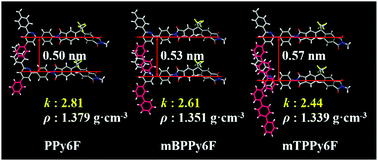Intrinsic low dielectric constant polyimides: relationship between molecular structure and dielectric properties†
Abstract
Low dielectric organic materials have been studied extensively, however, the relationship and regularity between the molecular structure and the dielectric properties is still not clear and barely reported. In this study, we report the synthesis of three polyimides (PPy6F, mBPPy6F and mTPPy6F) containing the same diphenylpyridine core structure but different side-chains with varied number of benzene rings. The polyimides PPy6F, mBPPy6F and mTPPy6F which contain one, two and three benzene rings in the pendant group, respectively, show intrinsic dielectric constant k values of 2.81 (PPy6F), 2.61 (mBPPy6F) and 2.44 (mTPPy6F). The reason for the reduced k value with increasing number of benzene rings in the pendant group is discussed through the investigation of morphology, density and water absorption properties of these polyimides. This discovery provides us with a new and easy strategy to obtain lower dielectric polymers. Polyimide mTPPy6F shows excellent comprehensive properties, with a high glass transition temperature (Tg) of 342 °C, a 5 wt% loss temperature (Td,5%) of 551 °C, tensile strength of 105 MPa, low moisture absorption of only 0.61% and good solubility in common organic solvents.



 Please wait while we load your content...
Please wait while we load your content...